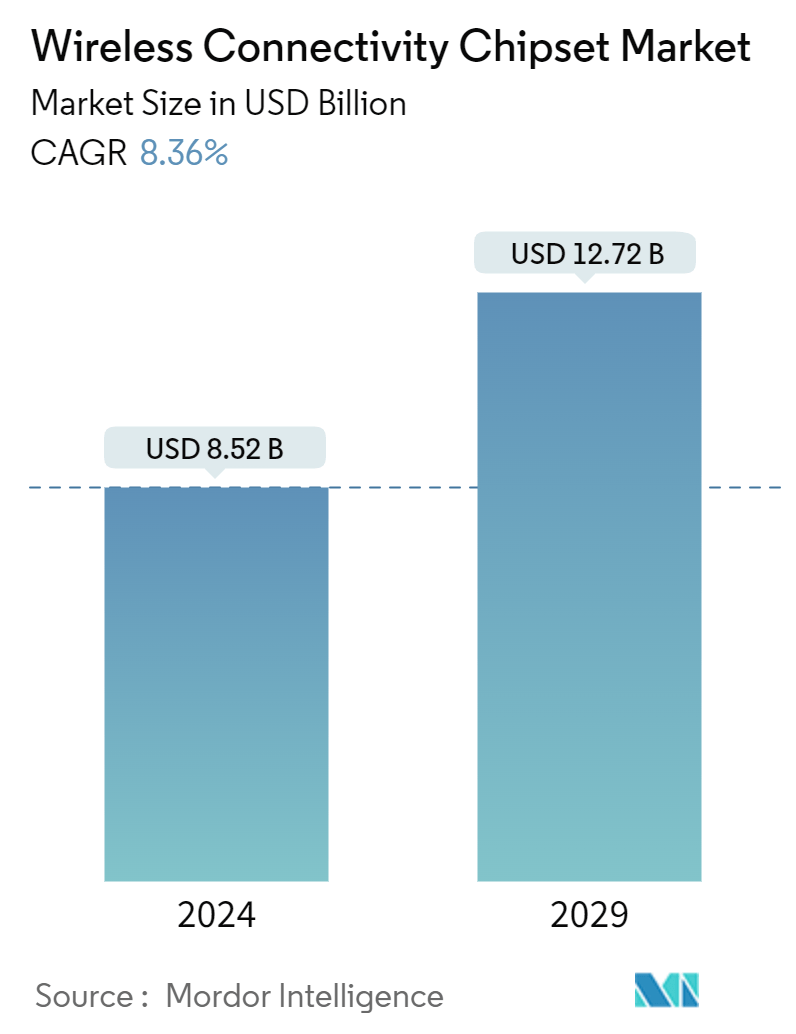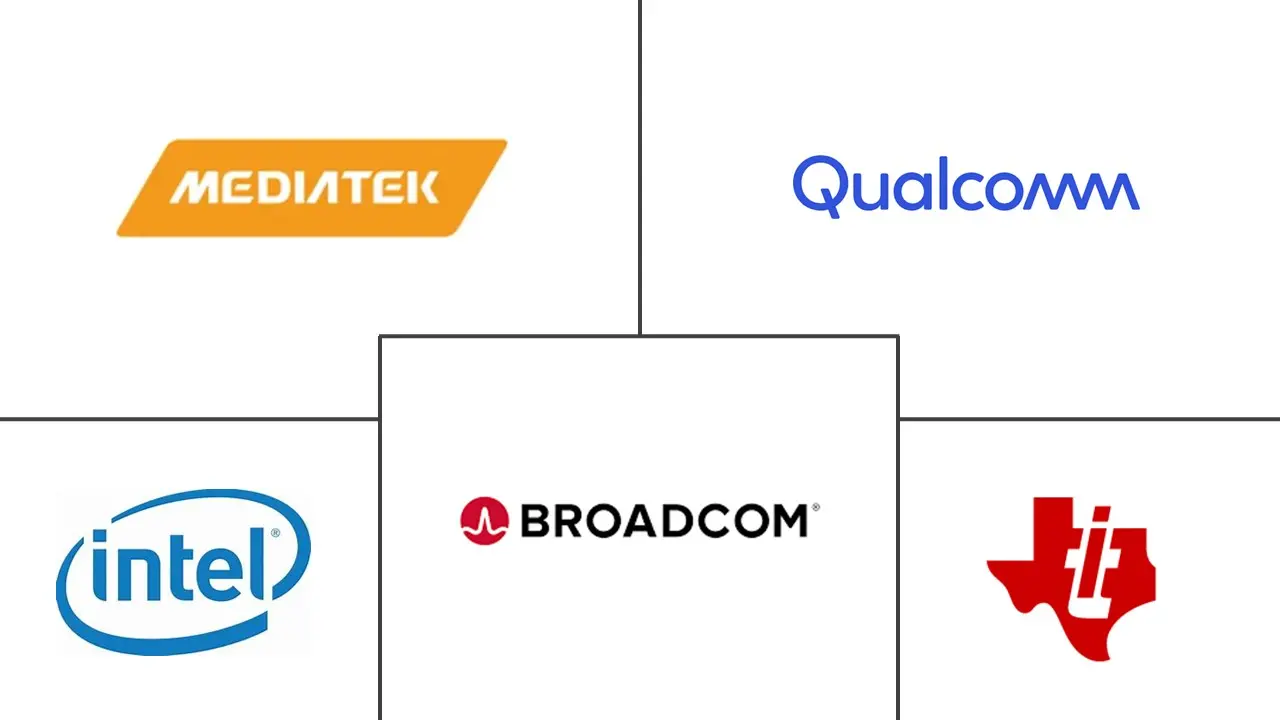Market Size of Wireless Connectivity Chipset Industry

| Study Period | 2019 - 2029 |
| Market Size (2024) | USD 8.52 Billion |
| Market Size (2029) | USD 12.72 Billion |
| CAGR (2024 - 2029) | 8.36 % |
| Fastest Growing Market | Asia-Pacific |
| Largest Market | Asia-Pacific |
Major Players
*Disclaimer: Major Players sorted in no particular order |
Wireless Connectivity Chipset Market Analysis
The Wireless Connectivity Chipset Market size is estimated at USD 8.52 billion in 2024, and is expected to reach USD 12.72 billion by 2029, growing at a CAGR of 8.36% during the forecast period (2024-2029).
- With the growing penetration of high-speed internet, the adoption of connected devices and smart home applications is increasing, especially in regions such as Europe, North America, and Asia-Pacific. Some major solutions include voice assistants, smart thermostats, smart lighting, security cameras, and smart appliances.
- Further, in May 2024, MediaTek announced the debut of two new chipsets with powerful performance and support for the latest AI enhancements across multiple verticals. These included the Kompanio 838 SoC for premium Chromebooks and the Pentonic 800 SoC for 4K premium smart TVs and displays. The company highlighted major developments in product categories such as AI, automotive, IoT, TVs, Chromebooks, and wireless connectivity.
- For instance, the IMT-2030 (6G) Promotion Group was formed in China to speed up the R&D of 6G technology. Around 2030, the world is anticipated to witness the commercialization of 6G. China is leading the charge in supporting the commercialization of 5G, which will provide a solid basis for developing 6G.
- Adding several devices, such as in IoT, increases the surface area of a network, creating more potential attack vectors in the process. Even a single unsecured device connected to a network may serve as a point of entry for an active attack on the network.
- According to the Organisation for Economic Co-operation and Development survey, by 2025, the number of households with computers is anticipated to increase to 1,262.47 million. Homes with at least one computer are referred to as computer households. Such a massive boost in computer adoption will create an opportunity for the market players to expand their Wi-Fi chipset product portfolio, expand their presence in different regions, and advance their market share.
- Various players in the market are developing new products to stay competitive, which may further propel market growth. For instance, in November 2023, MediaTek, an early pioneer in Wi-Fi 7 technology, solidified its position as a market leader with the launch of its latest offerings, the Filogic 860 and Filogic 360. These additions significantly expanded MediaTek's cutting-edge product line, emphasizing the latest connectivity technologies for superior performance and unwavering reliability.
- The Filogic 860 chipsets, featuring a dual-band access point and an advanced network processor, are tailored for enterprise access points, service provider gateways, mesh nodes, and various retail and IoT router applications. On the other hand, the Filogic 360 facilitates Wi-Fi 7 2x2 capabilities and dual Bluetooth 5.4 radios in a single chip. This design is specifically crafted to bring next-gen Wi-Fi 7 connectivity to edge and streaming devices, as well as a wide range of consumer electronics.
- High costs associated with developing and producing advanced Wi-Fi chipsets pose a significant challenge in the market. The sophisticated and expensive technology needed for manufacturing these chipsets inflates the final product's cost, potentially hindering adoption, especially among price-sensitive consumers.
- Post-COVID-19, there was a shift to opting for digital modes for relevant meetings and discussions while focusing more on adopting collaborative tools. Furthermore, emerging use cases for 5G, including the need to support increasing numbers of individuals schooling and working from home, are expected to drive 5G investment. In addition, many workplaces have adopted a hybrid model of working, for which 5G connections can be deployed for better connectivity. Such cases have positively driven the market despite the disruptions caused due to shortages in the supply chain.
Wireless Connectivity Chipset Industry Segmentation
A wireless chipset is designed to be a part of the internal hardware of wireless communication procedures to allow computers or systems to communicate with each other through wireless means, such as Wi-Fi, Bluetooth, or a combination of both.
The wireless connectivity chipset market is segmented by type (Wi-Fi standalone, Bluetooth standalone, Wi-Fi & Bluetooth combo, and low-power wireless IC), end-user applications (consumer, enterprise, mobile handsets, automotive, industrial, and other end-user applications), and geography (North America, Europe, Asia-Pacific, and the Rest of the World). The market sizes are provided in terms of value (USD) for all the above segments.
| By Type | |
| Wi-Fi Standalone | |
| Bluetooth Standalone | |
| Wifi and Bluetooth Combo | |
| Low-power Wireless IC |
| By End-user Application | |
| Consumer | |
| Enterprise | |
| Mobile Handsets | |
| Automotive | |
| Industrial | |
| Other End-user Applications |
| By Geography*** | |
| North America | |
| Europe | |
| Asia | |
| Australia and New Zealand | |
| Latin America | |
| Middle East and Africa |
Wireless Connectivity Chipset Market Size Summary
The wireless connectivity chipset market is poised for significant growth, driven by the increasing adoption of connected devices and smart home applications across regions such as Europe, North America, and Asia-Pacific. The market is experiencing a surge in demand due to the proliferation of high-speed internet and the rising penetration of 5G technology. Key players like MediaTek, Broadcom, and Qualcomm are at the forefront, introducing advanced chipsets that support the latest AI enhancements and connectivity technologies. The market is characterized by rapid technological advancements, with companies focusing on expanding their product portfolios and enhancing their presence through strategic partnerships and mergers. The evolution of Wi-Fi network technology and the growing demand for data-heavy services are further propelling the market, as consumers seek faster speeds and lower latency for applications like video streaming and cloud services.
Despite the promising growth prospects, the market faces challenges such as the high costs associated with developing and producing advanced Wi-Fi chipsets, which may hinder adoption among price-sensitive consumers. However, the increasing availability and affordability of 5G smartphones, coupled with the rapid adoption of smartphones in both metropolitan and rural areas, are expected to drive market expansion. The Asia-Pacific region, particularly China and India, is leading the charge in 5G development, with significant investments in network infrastructure and a growing consumer base for 5G-enabled devices. The market's fragmented nature, with numerous players vying for market share, underscores the competitive landscape, as companies continue to innovate and introduce new products to meet the evolving demands of consumers and businesses alike.
Wireless Connectivity Chipset Market Size - Table of Contents
-
1. MARKET INSIGHTS
-
1.1 Market Overview
-
1.2 Industry Attractiveness - Porter's Five Forces Analysis
-
1.2.1 Bargaining Power of Suppliers
-
1.2.2 Bargaining Power of Buyers
-
1.2.3 Threat of New Entrants
-
1.2.4 Threat of Substitutes
-
1.2.5 Degree of Competition
-
-
1.3 Assessment of the Impact of Macroeconomic Trends on the Market
-
-
2. MARKET SEGMENTATION
-
2.1 By Type
-
2.1.1 Wi-Fi Standalone
-
2.1.2 Bluetooth Standalone
-
2.1.3 Wifi and Bluetooth Combo
-
2.1.4 Low-power Wireless IC
-
-
2.2 By End-user Application
-
2.2.1 Consumer
-
2.2.2 Enterprise
-
2.2.3 Mobile Handsets
-
2.2.4 Automotive
-
2.2.5 Industrial
-
2.2.6 Other End-user Applications
-
-
2.3 By Geography***
-
2.3.1 North America
-
2.3.2 Europe
-
2.3.3 Asia
-
2.3.4 Australia and New Zealand
-
2.3.5 Latin America
-
2.3.6 Middle East and Africa
-
-
Wireless Connectivity Chipset Market Size FAQs
How big is the Wireless Connectivity Chipset Market?
The Wireless Connectivity Chipset Market size is expected to reach USD 8.52 billion in 2024 and grow at a CAGR of 8.36% to reach USD 12.72 billion by 2029.
What is the current Wireless Connectivity Chipset Market size?
In 2024, the Wireless Connectivity Chipset Market size is expected to reach USD 8.52 billion.

